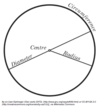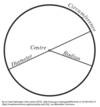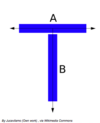Mathematics & Measurements Flashcards
This deck is a comprehensive review of math vocabulary, concepts, and conversions. Special thanks to Khan Academy and Wolfram Alpha for helping us learn some of the concepts in this deck! (35 cards)
Define:
Circumference
Circumference is the perimeter of a circle.

The circumference of a circle can be calculated using radius or diameter: C = 2 * π * r or C = π * d
How many sides does a pentagon have?
Five
Polygons are made using the Greek prefix for the number + the suffix “gon”. The other main polygons are:
- hexagon (6 sides)
- heptagon (7 sides)
- octagon (8 sides)
- nonagon (9 sides)
- decagon (10 sides)
- etc.
Convert:
1 inch to centimeters
1 inch = 2.54 centimeters
Which French philosopher and mathematician is famous for his creation of the Cartesian coordinate system, still used today in algebra and geometry?
René Descartes (1596-1650)

You may remember the Cartesian coordinate system as a plot of X, Y on a two-dimensional axis. This changed the way mathematicians were able to describe functions (correlational relationships).
__________ data includes numerical measurements and __________ data includes descriptive words.
Quantitative (or empirical); qualitative
How do you calculate percent change?
Percent change is calculated by dividing the difference between the two numbers by the original number, then multiplying by 100 to convert to percentage.
For example: A shirt was originally $4, but is now $6. What is the percent change?
Step 1: 6 - 4 = 2
Step 2: 2 / 4 = .5
Step 3: .5 * 100 = 50%
Define:
Diameter
Diameter is the distance from one side of a circle to the other measured in a straight line through the center.

Define:
Volume
Volume is the amount of space within a three-dimensional figure. It is measured in units of distance cubed.
Common volume equations include:
- Sphere: (4/3) * π * r3
- Cylinder: V = (π * r * r) * h
- Square Pyramid: V = (l * w * h) / 3
- Rectangular Prism: V = l * w * h
What is the Fibonacci Sequence?
The Fibonacci Sequence is a number sequence in which the next term is always the sum of the previous two.
0, 1, 1, 2, 3, 5, 8, 13, 21, etc.
The sequence is named after the Italian mathematician Fibonacci, though its origins actually come from early Indian mathematics.
Define:
normal distribution
Bell-shaped, symmetric curve that represents data about many natural phenomena throughout the population

What is the difference between Fahrenheit and Celsius?
Fahrenheit and Celsius are both units of measure for temperature. Fahrenheit is primarily used in the United States, whereas Celsius is part of the metric system and is used worldwide.
Converting Fahrenheit and Celsius can be achieved using some basic math:
°F = (°C × 9/5) + 32
°C = (°F − 32) x 5/9
Define:
perpendicular
Lines that form a 90º angle at their intersection.

What is an imaginary number and why are they important?
An imaginary number is any number that when squared, results in a negative number.
Imaginary numbers were once mocked and thought to be useless, but have since been applied to serious mathematics applications. One such example is in electronics, where imaginary numbers are used to calculate current.
Define:
Acre
A measure of area; measures exactly 43,560 square feet.
Define:
Area
Area is the measure of space on a surface. It is measured in units squared.
Common area equations include:
- Circle: A = π r^2
- Triangle: A = 1/2 b * h
- Rectangle: A = s1 * s2
- Parallelogram: A = b * h

Define:
Factors
Factors are numbers that a number is evenly divisible by. For example, the factors of 12 are 1, 2, 3, 4, 6, and 12.
Define:
Mean
The average of a group of numbers.
For example, the mean of 1, 2, 3, 4, 5 is 3.
Define:
Median
The middle number in a set of numbers when they are ordered from least to greatest.
For example, the median of 1, 4, 2, 9, and 7 is 4.
Define:
Mode
The most commonly occurring number in a set.
For example, the mode of 1, 1, 2, 2, 2, 6, 7, 7 is 2.
Define:
Multiples
Multiples are numbers that result when you multiply a number.
For example, the multiples of 3 include 3, 6, 9, 12, etc.
Define:
parallel
Lines that are the same distance apart at every point along their length and never touch are called parallel.

What is pi?
In a circle, the ratio of its circumference to diameter is always pi.
Pi is usually rounded to 3.14, but is actually an infinite decimal that never repeats or ends. The first several digits are: 3.14159265358979
What are the qualifications for a number to be considered prime?
A number is prime if it is divisible by only 1 and itself.
For example, 11 is prime, since its only factors are 1 and 11. The opposite of a prime number is called a composite number. 10 is not prime, and would therefore be categorized as composite, since its factors include 1, 2, 5, 10.
Exceptions:
- 0 is neither prime nor composite.
- 1 is neither prime nor composite. A common misconception is that 1 is prime, but it is not technically “divisible by 1 AND itself.”
Define:
Radius
The distance from the center of a circle to its edge.



